
Josef Antonius Heinrich Terboven was a German Nazi Party official and politician who was the long-serving Gauleiter of Gau Essen and the Reichskommissar for Norway during the German occupation.
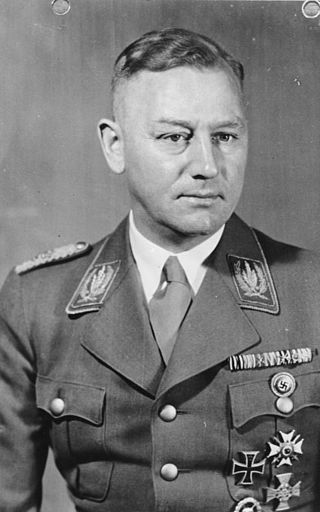
Viktor Lutze was a German Nazi Party functionary and the commander of the Sturmabteilung ("SA") who succeeded Ernst Röhm as Stabschef and Reichsleiter. After he died from injuries received in a car accident, Lutze was given an elaborate state funeral in Berlin on 7 May 1943.
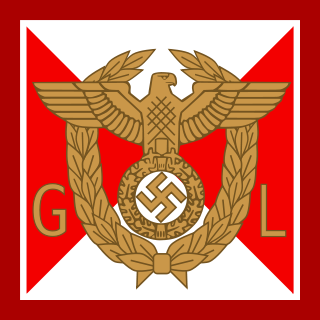
A Gauleiter was a regional leader of the Nazi Party (NSDAP) who served as the head of a Gau or Reichsgau. Gauleiter was the third-highest rank in the Nazi political leadership, subordinate only to Reichsleiter and to the Führer himself. The position was effectively abolished with the fall of the Nazi regime on 8 May 1945.
Awards and decorations of Nazi Germany were military, political, and civilian decorations that were bestowed between 1923 and 1945, first by the Nazi Party and later the state of Nazi Germany.

The Blood Order, officially known as the Decoration in Memory of 9 November 1923, was one of the most prestigious decorations in the Nazi Party (NSDAP). During March 1934, Hitler authorized the Blood Order to commemorate the 9 November 1923 coup attempt of the Nazi Party. The medal is silver, with the obverse bearing a depiction of an eagle grasping an oak leaf wreath. Inside the wreath is the date 9.Nov. and to the right is the inscription München 1923–1933. The reverse shows the entrance of the Feldherrnhalle in relief, and directly above is the angled swastika with sun rays in the background. Along the top edge is the inscription: UND IHR HABT DOCH GESIEGT.
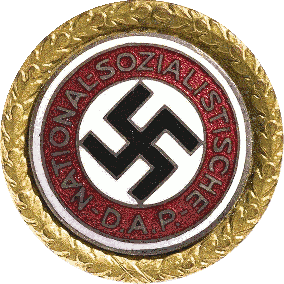
The Golden Party Badge was an award authorised by Adolf Hitler in a decree in October 1933. It was a special award given to all Nazi Party members who had, as of 9 November 1933, registered numbers from 1 to 100,000 and had unbroken Party membership. The recipient's party number was inscribed on the reverse of the badge. Only 20,487 men and 1,795 women were awarded the badge on these terms.

Joseph Bürckel was a German Nazi politician and a member of the German parliament. He was an early member of the Nazi Party and was influential in the rise of the National Socialist movement. He played a central role in the German acquisition of the Saarland and Austria. He held the posts of Gauleiter and Reichsstatthalter in both Gau Westmark and Reichsgau Vienna.

The Wound Badge was a German military decoration first promulgated by Wilhelm II, German Emperor on 3 March 1918, which was first awarded to soldiers of the German Army who were wounded during World War I. Between the world wars, it was awarded to members of the German armed forces who fought on the Nationalist side of the Spanish Civil War, 1938–39, and received combat related wounds. It was awarded to members in the Reichswehr, the Wehrmacht, SS and the auxiliary service organizations during World War II. After March 1943, due to the increasing number of Allied bombings, it was also awarded to civilians wounded in air raids. It was awarded when the wound was the result of enemy hostile action. In 1957, the West German government authorized a denazified version of the basic badges for wear on the Bundeswehr uniform, among other certain Nazi-era wartime awards.

Political decorations of the Nazi Party were medals and awards issued by the National Socialist German Workers Party (NSDAP) between 1920 and 1945. Political awards were authorised for wear on any paramilitary uniform of Nazi Germany, as well as civilian attire, but were generally discouraged on Wehrmacht military uniforms. The Waffen-SS freely wore both political awards and military decorations on their uniforms.
The term Frontbann refers to a reorganized front organization of the Sturmabteilung or SA which was formed in April 1924. It was created to replace the SA which had been banned in the aftermath of the failed Munich Putsch. It was disbanded in February 1925 after the ban on the SA was lifted.
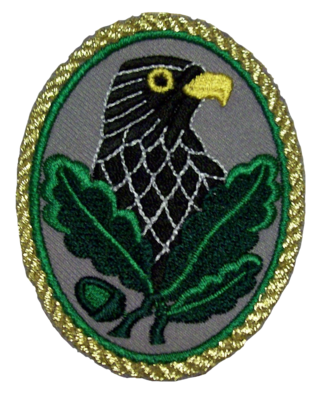
The Sniper's Badge was a World War II German military decoration awarded to snipers. It was instituted on 20 August 1944. Initially, only personnel serving in the German Army and the Waffen-SS were eligible. Later, by order of the High Command, it was also made available to snipers of the other armed services.

The Parachutist Badge was a badge awarded to qualified parachutists of the Wehrmacht and the Waffen-SS of Nazi Germany.
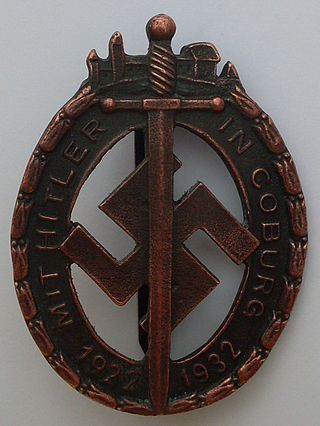
The Coburg Badge was the first badge recognised as a national award of the Nazi Party (NSDAP). Subsequently, it formally was given precedence as the highest Party award.
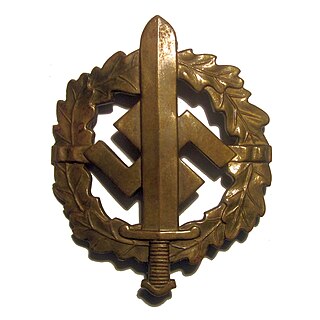
The SA Sports Badge was a decoration of Nazi Germany that was issued between the years 1933 and 1945. It was a political version of the much more generic German Sports Badge, which was also issued in great numbers by the Nazis. At its center was a 57mm high Roman broad sword, superimposed over a Nazi swastika encircled by an wreath of oak leaves. It was a pin-back badge, but there was a cloth version, as well.

The Nuremberg Party Day Badge was the second badge recognised as a national award of the Nazi Party (NSDAP). Also known as the Nuremberg Party Badge of 1929, it was awarded to those Nazi Party members who had attended the 1929 national rally in the city of Nuremberg. After the establishment of Nazi Germany, it formally was given precedence as the second highest Party award in a decree of 6 November 1936.
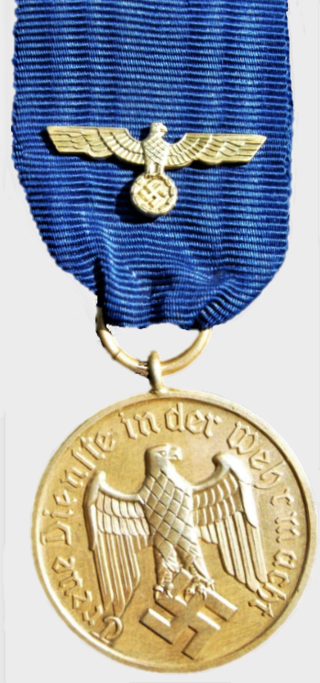
The Wehrmacht Long Service Award was a military service decoration of Nazi Germany issued for satisfactory completion of a number of years in military service.

The Nazi Party Long Service Award, sometimes called the NSDAP Long Service Award, was a political award in the form of a badge of the Nazi Party.

The German Horseman's Badge also referred to in general terms as the German Equestrian Badge, was a sports decoration of the Weimar Republic and Nazi Germany. It was awarded for proficiency in riding horses. Equestrian badges remain a part of German rider training today, although their appearance is completely different.
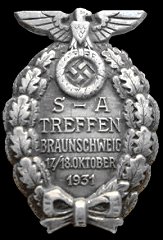
Brunswick Rally Badge, also known as the Badge of the SA Rally at Brunswick 1931, was the third badge recognised as a national award of the Nazi Party (NSDAP). A special Party honour badge, it was awarded to those Party members who had attended the SA assembly at the city of Braunschweig in the Free State of Brunswick on 17-18 October 1931. After the establishment of Nazi Germany, the badge formally was given precedence as the third highest Party award in a decree of 6 November 1936.
The National Socialist Working Association, sometimes translated as the National Socialist Working Community was a short-lived group of about a dozen Nazi Party Gauleiter brought together under the leadership of Gregor Strasser in September 1925. Its full name was the Arbeitsgemeinschaft der nord- und westdeutschen Gaue der NSDAP. Aligned with the Strasserist wing of the Party, it unsuccessfully sought to steer the Party leadership in that direction by updating the Party program of 1920. Party Chairman Adolf Hitler perceived the Association as a threat to his leadership, so its activities were curtailed shortly after the Bamberg Conference of 14 February 1926 presided over by him, and it was formally dissolved on 1 October of that year.

















